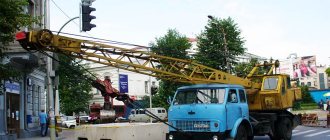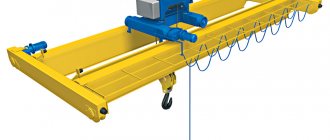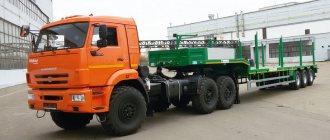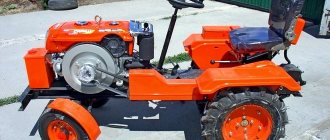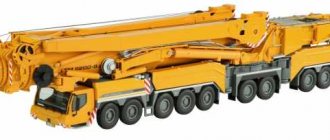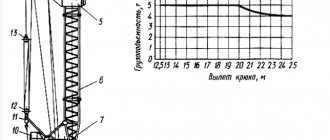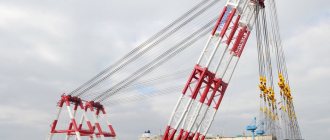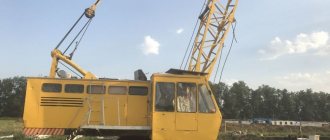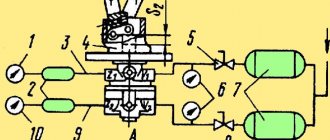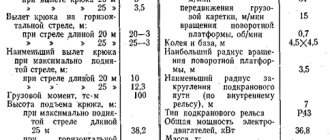Models
All machines have a unified design with separate electric motors for each mechanism. The hydraulic system is installed only on later versions. The crane installation is controlled by levers and pedals from a separate driver’s cabin located on the turntable. The lifting capacity of the machines is 7.5-14 tons.
SMK-7
The SMK-7 crane is an early modification of the machine, which used MAZ-200 trucks equipped with an in-line 2-stroke supercharged diesel engine as a base. On board the crane there was a special cargo winch designed to pull cargo into the work area.
The SMK-7 truck crane was later modernized by moving the installation onto a MAZ-5334 chassis equipped with a 4-stroke diesel engine with a power of 180 hp. The carrying capacity of all options is 7.5 tons.
SMK-10
Diesel-electric crane with a lifting capacity of 10 tons, built on the basis of a MAZ-5334 truck. A special feature of the design are screw outriggers, which are adjusted manually. The equipment was equipped with a 10 m long boom, which allowed the installation of 2 additional sections (3 m each). The design of the crane does not allow for movement with a load suspended on a hook. It is allowed to rotate the tower while lowering or raising the load or boom.
SMK-14
The SMK-14 truck crane, which has a lifting capacity of 14 tons, uses a MAZ-5337 truck as a base. The machine drives are equipped with asynchronous electric motors with an operating voltage of 380 V. The energy source is a generator mounted on a vehicle chassis. The rotor is driven by a power take-off gearbox mounted on the gearbox.
The generator has a distribution box designed for connecting external devices with a total power of no more than 30 kW. It is allowed to power consumers installed on the tap from an external 3-phase alternating current source. The SMK-14 truck crane connected according to this scheme can be used in rooms with poor ventilation.
SMK-101
The SMK-101 crane, designed to move cargo weighing up to 10 tons, is based on the MAZ-5334 commercial truck chassis. The crane installation is installed on a support circuit equipped with hydraulically driven outriggers. The hydraulic circuit includes a gear pump driven by a separate electric motor with a power of 3 kW.
Brief description of the technical characteristics of the machine:
- boom length - 8.6 m;
- extension insert size - 3 m;
- allowed number of inserts - 3;
- jib length - 1.5 m;
- load capacity at maximum boom and jib length - 2.5 t;
- superstructure rotation speed - 0.4-1.7 rpm;
- crane working area - 360°;
- generator power - 30 kW;
- engine power of the main and jib winch - 17.5 kW;
- rotation gear motor power - 4.1 kW;
- average fuel consumption during operation of the installation is 6.46 liters per hour.
Assemblies equipped with rollers or balls are used as a rotary shoulder strap. A stabilizer is installed in the machine’s suspension design, which eliminates distortions of the equipment during operation. On board the vehicle there is a separate winch for pulling loads, equipped with a 4.2 kW electric motor.
Specifications
Thanks to the strengthening of the frame, the vehicle's load capacity has increased. It was 8.2 tons versus 7.5 for the 500th model, on the basis of which the 5334 was designed. At the same time, fuel consumption became 3 liters lower and amounted to 22 l/100 km. I would like to note that these figures directly affect the economic indicators of profitability and transportation in general.
Due to changed safety requirements, headlights were placed on the bumper. However, the turn signals and markers remained on the sides of the radiator grille. This simplified the wiring diagram.
In addition, when driving, the cabin vibrated on potholes. Accordingly, when the headlights located on the front of the old cabin were turned on, a beam of light was pulled. When they were transferred to a rigid bumper, which was part of the frame, this problem disappeared and the beam of light always came out smoothly.
This arrangement of lighting allowed for less glare on oncoming drivers. The grille has also changed. Then the MAZ 500 A had large horizontal slots. And now with small slots, and it has become noticeably wider, which improves engine cooling.
Cabin
It is a three-seat design with a streamlined design and good visibility. The salon is quite spacious, but with a minimal level of comfort. The driver's seat was adjustable - forward/backward and backrest tilt, and it was also equipped with a shock-absorbing mechanism. Separately, it should be noted that there is a sleeping place in the back for long trips.
Thanks to the powerful stove, it was warm inside the cabin even in severe frost. But in hot weather, drivers could only escape by opening the windows, since there was no air conditioning.
The windshield is divided in two by the B-pillar. Because of this, there was no need to replace the whole glass when half was broken. In addition, the cabin rigidity is increased.
Transport management system
The steering was equipped with a hydraulic booster. Therefore, it was possible to turn the steering wheel, located almost vertically, without applying much effort.
By the way, the instrument panel had a well-thought-out layout. Sensors installed on it informed the driver about all the most important parameters. They also notified about possible system malfunctions. And behind the panel near the window there was space for small things.
Engines
For the truck based on model 5334, there was a choice of two engines supplied by the Yaroslavl Motor Plant:
- The first of them is a V-shaped YaMZ 236 with 6 cylinders, power - from 180 to 230 horsepower. The maximum possible torsional moment was 667 N.m. It was achieved at 1500 rpm. Therefore, the engine pulled well at the low end. But there was a serious drawback of the 236th - strong vibrations during operation. The designers partially solved this problem by installing a power unit with a gearbox on three cushions.
- The second is the eight-cylinder V-shaped YaMZ 238, already producing 240 - 300 hp. Accordingly, its fuel consumption was higher. Access to the power unit was achieved by tilting the cab forward. The gearbox used was a five-speed manual. The clutch is a double-disc friction clutch.
Device
The MAZ 5334 had much higher technical characteristics than the 500 series.
The wheel formula of the car is 4x2, the rear axle is driven. In general, the car was designed in such a way that by changing the tire sizes and the number of teeth in the wheel gearboxes, the required gear ratio was achieved. This helped, depending on the purpose of the modification, to increase or decrease this indicator. There was also the opportunity to achieve optimal performance.
The 2-circuit braking system already had a drive divided along all axes. The car's suspension uses extended springs and improved shock absorbers. Thanks to this, the safety and controllability of MAZ has increased.
The main parameters of the car chassis are shown in the table below.
11.15 at 2100 rpm 180 at 1500 rpm 667
Chassis
For stability in the transverse direction, some models use sliding trolleys. The main part is a fixed frame, which is supported by two crawler tracks with a drive. The tracks consist of numerous links and have a large area of support on the ground, which ensures low pressure, only about 0.1 MPa.
Instead of a mechanical drive, modern cranes today have a hydraulic drive. And such models are in good demand. They have two pumps. This allows you to simultaneously perform any operations, for example, lifting and turning, movement without a drop in pressure in the hydraulic system. Any operations on such cranes are performed accurately and smoothly. This is ensured by proportional valves in the hydraulic control. On cranes with hydraulics, the crane operator does not need to exert much effort to operate.
Some of the latest models of crawler cranes on the Russian market are equipped with a telescopic boom. Such an arrow provides a number of advantages. The required length is achieved not by installing additional inserts, but simply by extending the boom. It also becomes possible to transfer cargo in an additional plane.
Until recently, telescopic booms had almost 50% less lifting capacity than lattice booms. But today, ovoid profiles have begun to be used in telescopic booms, which has already increased their load capacity and continues to increase due to new technical solutions.
Moreover, the cost of cranes with lattice and telescopic booms is approximately the same, and sometimes the telescopic version is even cheaper.
In Europe, crawler cranes with telescopic booms are already very widespread.
Germany
TAKRAF
Indexation of truck-mounted, crawler, pneumatic wheel cranes of the TAKRAF brand:
Index ADK (German: Auto Dreh Krane, automobile rotary crane). Used for automotive cranes. After the letter designation, the carrying capacity in tons is indicated:
- ADK-3 is a truck-mounted crane with a lifting capacity of 3 tons.
If the crane is equipped with a telescopic boom, some models were indicated with the letter “T”. After indicating the load capacity, the serial number of the modification is given.
EDK (German: Eisenban Dreh Krane, railway slewing crane) Used for railway cranes. Load capacity:
- EDK-300 (60 t);
- EDK-500 (80 t);
- EDK-1000 (125 t);
- EDK-2000 (250 t).
Index MDK (German: Mobil Dreh Krane, mobile rotary crane). Used for pneumatic wheel cranes. After the letters “MDK” there are two numbers indicating the load capacity in tons:
- MDK-50 - mobile slewing crane, lifting capacity 50 tons, basic model.
If there is a difference from the base model, after indicating the load capacity, the serial number of the modification is given:
- MDK-504 is a mobile slewing crane with a lifting capacity of 50 tons, fourth modification.
Index RDK (Raupen Dreh Krane - crawler slewing crane). Used for crawler cranes. After the letters “RDK” there are two or three numbers indicating its load capacity.
- RDK 25 is a crawler slewing crane with a lifting capacity of 25 tons, the basic model.
- RDK 250 is a crawler slewing crane with a lifting capacity of 25 tons, the basic model.
- RDK 280 is a crawler slewing crane with a lifting capacity of 28 tons, the basic model.
Important Cultivators for hilling potatoes and cultivating land
If it differs from the base model, the serial number of the modification is indicated with a hyphen. Example:
- RDK 250-3 is a crawler slewing crane, with a lifting capacity of 25 tons, of the third modification.
- RDK 630-1 is a crawler slewing crane, with a lifting capacity of 63 tons, the first modification.
When manufacturing a faucet in a special climatic design, after the modification number, a special designation characterizing it is added; for example, if the crane is made in the “northern” design, the Polar designation is added:
- RDK 250-4 Polar - crawler slewing crane, lifting capacity 25 tons, northern version.
FAUN
Truck cranes on special chassis from FAUN. This type of crane is intended for installation, as well as loading and unloading operations at dispersed bridge construction sites in temperate climates. Indexation is shown in the following example:
Crane HK-100.05 - crane with a lifting capacity of 100 tons, 5th model.
Crane SMK-101 with a lifting capacity of 10 tons
Construction machines and equipment, reference book
Crane SMK-101 with a lifting capacity of 10 tons
TO
category:
Self-propelled jib cranes
Crane SMK-101 with a lifting capacity of 10 tons
The SMK-101 crane is mounted on the MA3-5334 vehicle chassis. The drive of the crane is mechanical, the rest of the mechanisms are electric from its own generator.
Rice. 1. Truck crane SMK-101
Rice. 2. SMK-101 boom 8.6 m
Rice. 3. SMK-101 boom 11.6 m
The main boom, 8.6 m long, consists of two sections, extended with inserts up to 11.6; 14.6; 17.6 m. The 17.6 m long boom can be equipped with a 3.28 m long jib. The crane can have a load pulling mechanism. Working with a hook on a jib is provided at a reach of 7.5 m with a load capacity of 2.5 tons and a hook lifting height of 20 m. It is possible to move with a load weighing 2.5 tons on the hook of the main boom in the “backward boom” position at a reach of 3 m at a speed of 5 km/h with a hook lifting height of 5.5 m. Lowering depth is 3 m with a lifting capacity equal to half the rating. Crane weight—15 tons. Wheel track: front—1970 mm, rear—1860 mm. The turning radius of the crane 32 along the track of the outer front wheel is 12.5 m. The maximum load on the outrigger is 210 kN (21 t). The characteristics of the crane are shown in Fig. 4.35—4.40.
Fig 4. CMK-101 boom 17.6 m
Rice. 5. SMK-101 boom 14.6 m
Rice. 6. SMK-101 boom 8.6 m on the move
Rice. 7. SMK-101 boom 17.6—3.28 m
TO
category: – Self-propelled jib cranes
Crane SMK-10 with a lifting capacity of 10 tons
Construction machines and equipment, reference book
Crane SMK-10 with a lifting capacity of 10 tons
TO
category:
Self-propelled jib cranes
Crane SMK-10 with a lifting capacity of 10 tons
The SMK-10 crane is mounted on the chassis of a MAZ-500 vehicle. The drive is electric from its own generator or from an external three-phase current network with a voltage of 380 V. The main boom, 10 m long, consists of two sections; with the help of inserts it is extended to 13 and 16 m. The crane is equipped with a load pulling winch. Crane weight—14.55—14.8 tons. Wheel track: front—1950 mm, rear—1900 mm. The turning radius of the crane along the track of the outer front wheel is 8.5 m. The working area with load is 270°. Maximum outrigger load is 105 kN (10.76 t). Load on the chassis axles in transport position: on the front - 46 kN (4.67 t), on the rear - 97 kN (9.88 t).
Rice. 1. AK-8 boom 7.5-4.2 m
Rice. 2. SMK-10 boom 16 m
Rice. 3. SMK-10 boom 10 m
Rice. 4. SMK-Yu boom 13 m
The characteristics of the crane are shown in Fig. 1-3.
TO
category: – Self-propelled jib cranes
Refuelers
From 1980 to 1984, an automobile tank on a MAZ chassis was assembled at the Bataysk Energy-Mechanical Plant. It was called ACM-8-5334. It was a fuel oil tanker for transporting heavy petroleum products.
Find out the technical characteristics of KamAZ-53212, such as load capacity, dimensions, the possibility of equipping with additional equipment, etc. This article will help you understand the prices of Case tractors.
The following information: https://spez-tech.com/tehnika/selhoz/uborochnaya/opisanie-zernodrobilki-zubr.html contains generalized reviews of Zubr-2A grain crushers and other models of this company.
At the same time, the TZA-7.5-5334 automobile fuel tanker was designed at the Tikhoretsky Machine-Building Plant, which went into production in 1981.
Sixty percent of all production went to the needs of the army - mainly for refueling aircraft. Twenty-five were sent to civil aviation, the rest went to the national economy.
Even the flattened shape of the tank on this tanker is a necessary measure in order for the vehicle to fit into the cargo compartment of heavy BTA aircraft.
Due to the installation of additional equipment in the form of pumps, pipelines, hoses, dispensing units and refueling nozzles, the vehicle weighed up to 16.5 tons.
Today there are quite a lot of offers on the market for conversion TZA-7.5-5334. In Soviet times, military acceptance at factories was very strict in selecting products, even rejecting cars with scratches on the instrument glasses.
Therefore, you can count on the good condition of the offered army vehicles.
The price on the automobile market for fuel tankers is quite reasonable: a car produced in 1987 can be bought for 250,000 rubles, a car produced in 1992 can be purchased for 450,000 rubles.
Models
All machines have a unified design with separate electric motors for each mechanism. The hydraulic system is installed only on later versions. The crane installation is controlled by levers and pedals from a separate driver’s cabin located on the turntable. The lifting capacity of the machines is 7.5-14 tons.
The SMK-7 crane is an early modification of the machine, which used MAZ-200 trucks equipped with an in-line 2-stroke supercharged diesel engine as a base. On board the crane there was a special cargo winch designed to pull cargo into the work area.
The SMK-7 truck crane was later modernized by moving the installation onto a MAZ-5334 chassis equipped with a 4-stroke diesel engine with a power of 180 hp. The carrying capacity of all options is 7.5 tons.
SMK-10
Diesel-electric crane with a lifting capacity of 10 tons, built on the basis of a MAZ-5334 truck. A special feature of the design are screw outriggers, which are adjusted manually. The equipment was equipped with a 10 m long boom, which allowed the installation of 2 additional sections (3 m each). The design of the crane does not allow for movement with a load suspended on a hook. It is allowed to rotate the tower while lowering or raising the load or boom.
SMK-14
The SMK-14 truck crane, which has a lifting capacity of 14 tons, uses a MAZ-5337 truck as a base. The machine drives are equipped with asynchronous electric motors with an operating voltage of 380 V. The energy source is a generator mounted on a vehicle chassis. The rotor is driven by a power take-off gearbox mounted on the gearbox.
The generator has a distribution box designed for connecting external devices with a total power of no more than 30 kW. It is allowed to power consumers installed on the tap from an external 3-phase alternating current source. The SMK-14 truck crane connected according to this scheme can be used in rooms with poor ventilation.
SMK-101
The SMK-101 crane, designed to move cargo weighing up to 10 tons, is based on the MAZ-5334 commercial truck chassis. The crane installation is installed on a support circuit equipped with hydraulically driven outriggers. The hydraulic circuit includes a gear pump driven by a separate electric motor with a power of 3 kW.
Important How to assemble and install a tower crane at a construction site
Brief description of the technical characteristics of the machine:
- boom length - 8.6 m;
- extension insert size - 3 m;
- allowed number of inserts - 3;
- jib length - 1.5 m;
- load capacity at maximum boom and jib length - 2.5 t;
- superstructure rotation speed - 0.4-1.7 rpm;
- crane working area - 360°;
- generator power - 30 kW;
- engine power of the main and jib winch - 17.5 kW;
- rotation gear motor power - 4.1 kW;
- average fuel consumption during operation of the installation is 6.46 liters per hour.
Assemblies equipped with rollers or balls are used as a rotary shoulder strap. A stabilizer is installed in the machine’s suspension design, which eliminates distortions of the equipment during operation. On board the vehicle there is a separate winch for pulling loads, equipped with a 4.2 kW electric motor.
Drilling rigs
A number of Russian factories, such as the Bryankovsky Drilling Equipment Plant or Izhmashstanko, at one time launched the production of drilling rigs on the MAZ-5334 chassis. This equipment allows drilling to depths of up to 500 meters or more.
The average price is about 800,000 rubles.
Having studied the supply and demand in today's automobile market, we can say with confidence that the MAZ-5334 car, born back in 1977, still feels confident on the roads of Russia.
The affectionate nickname “Mazai” has long been assigned to him. The undoubted leadership belongs to the MAZ-5334 truck crane, the technical characteristics of which allow us to solve all assigned tasks with high quality.
In conclusion, let’s watch a video review in which they will tell us about the features of operating a tanker based on the MAZ-5334:
If you find an error, please select a piece of text and press Ctrl+Enter.
Technical features of the SMK-10 truck crane
The SMK-10 crane is mounted on the chassis of a MAZ-500A vehicle and has a maximum lifting capacity of 10 tons. It is used with jib working equipment with booms 10 and 16 m long. The crane is also equipped with a device for pulling loads into the work area. Can only be operated on outriggers. Moving with cargo is not possible. Any combined movements are possible. The crane drive is electric from the ECC-83-6M generator with a power of 132.5 kW. The generator rotor rotates from the diesel power plant and chassis. Each crane mechanism is driven by an individual electric motor. The crane can be connected to a stationary power supply. Design features of the crane: the boom lifting mechanism is equipped with two brakes, a ball slewing ring, a bevel-helical gearbox for the rotating platform rotation mechanism, a winch for pulling loads into the crane work area, outriggers with manual screw jacks. The mechanism for lifting the load is equipped with a brake with a hydraulic pusher, which ensures a smooth landing of the load when lowering it.
Technical characteristics of the SMK-10 truck crane
| Boom length, m | 10 |
| Load capacity, t, at departure | |
| the smallest | 10 |
| the greatest | 2 |
| when traveling with a load | — |
| Reach, m: | |
| least | 4 |
| greatest | 9,5 |
| Lifting height, m, at departure: | |
| the smallest | 10,5 |
| the greatest | 6,0 |
| Lifting speed, 10-2 m/s | 5,83-16,7 |
| Crane travel speed, km/h: | |
| working | — |
| transport | 40 |
| Rotation speed, min-1 | 1,0-1,5 |
| Car chassis | MAZ-500A |
| Vehicle power unit power, kW | 132,5 |
| Wheel track, m: | |
| front | 1,95 |
| rear | 1,9 |
| Distance between outriggers, m: | |
| along the longitudinal axis | 4,02 |
| across the longitudinal axis | 4,5 |
| Overall dimensions in transport position, m: | |
| length | 13,42 |
| width | 2,81 |
| height | 3,86 |
| Axle load, kN: | |
| front | — |
| rear | 103 |
| Weight of the crane in working condition, t | 14,6 |
Scheme of the SMK-10 truck crane
The SMK-10 crane (Fig. 24) with a lifting capacity of 10 tons is mounted on the chassis of a MAZ-500 vehicle with an individual electric drive of the mechanisms. The chassis is equipped with a torsion stabilizer and manually mounted rotary outriggers. The rotary support is a double-row ball bearing. The main boom equipment includes a rigid lattice boom, and the replacement equipment includes a rigid extended boom.
Rice. 24. Crane CMK-10, graphs of lifting capacity (solid lines) and hook lifting height (dashed lines): 1— for the main boom on outriggers; 2 - the same, for an extended boom
The location of various buttons, instrumentation and other devices on the control panel is shown in Fig. 25. When transporting a crane by rail with a 02-T gauge, the cabin is removed from the rotating frame, and the brackets under the cabin are covered with a tarpaulin.
The kinematic scheme (Fig. 26) differs from the usual scheme by the presence of a winch VIII for pulling up the load. The crane has an individual electric drive from a synchronous three-phase current generator ECC5-83-6M-101 with a power of 37.5 kW, voltage 400 V, rated speed 1000 rpm with a semiconductor or mechanical rectifier and stabilizing device. The generator rotates from the base vehicle engine through a gearbox, cardan drive, special drive mechanism and V-belt drive.
Rice. 25. Control panel SMK-10: 1 - switch for oil pressure and water temperature indicators; 2 - plug socket; 3 - voltmeter; 4 — water temperature indicator; 5 — sound signal button; 6 — OGP alarm lamp; 7 — OGP switch; 8 - ammeter; 9 — electric furnace switch; 10 — oil pressure indicator; 11 — headlight, lamp and sound signal switches; 12 — signal lamp indicating readiness for work; 13 — generator excitation button; 14 — control handle for the load lifting mechanism controller; 15 — switch handle for slow descent of the load; 16 — starter control buttons; 17 — handle of the switch for controlling the crane rotation mechanism; 18 — safety block; 19 — handle of the pull-up mechanism control switch; 20 — control handle for the boom lifting mechanism controller; 21 - electric furnace
Rice. 26. Kinematic diagram of the SMK-Yu crane: I - gearbox; II - V-belt drive; III - special generator drive mechanism; IV - generator; V and VI - jib and cargo winches; VII - rotation mechanism; VIII - winches for pulling loads
Internal and external features
Drivers, in addition, believe that by lowering the headlights lower, the designers improved the illumination of the roadway. A well-thought-out grille design with wide openings has improved engine cooling.
A characteristic feature of the cabin is the windshield, divided in the middle by a narrow vertical partition.
Compared to the design of modern heavy-duty trucks, it looks somewhat unusual, but this has a certain advantage. If one of the glasses is damaged, the second remains intact.
And this also affects the strength of the body for the better. The rounded contours of the cabin have a positive effect on the aerodynamic properties of the car : less turbulence is formed during movement and strong side winds.
The interior space is designed for driver convenience. The seat on special shock-absorbing devices allows you to calmly overcome any bumps and unevenness. Conveniently located, almost vertical steering wheel.
The instrument panel is clearly visible and has a pleasant backlight. Enough space to store personal items and small tools.
The high load capacity and strong driving characteristics of the MAZ-5334 are ensured by the diesel propulsion system of the Yaroslavl Motor Plant.
The base engine is a six-cylinder low-speed V-shaped YaMZ-236 with a power of 150-300 hp. With. In some configurations, when greater load capacity is required, an eight-cylinder YaMZ-238 is installed, which can produce 235-420 hp. With. at the same speed.
The gearbox is original, Yaroslavl, three-way five-speed, 2-3 and 4-5 speeds are synchronized. Stable operation of the engine is ensured by a six-section spool-type injection pump with an injection advance clutch.
MAZ-5334 has the following technical characteristics:
- overall dimensions in meters: 7.14x2.5x2.65;
- wheel formula 4x2, that is, the driving wheels are rear;
- load capacity 8,200 kg;
- gross weight with load 15,225 kg;
- permitted trailer weight with cargo 13,000 kg;
- maximum speed 85 km/h;
- acceleration time to 60 km/h 50 seconds;
- fuel consumption 22 l per 100 km;
- the maximum possible rise is 25%.
Car MAZ-5334
Development based on the MAZ-5335 chassis - MAZ-5334 truck. A more modern truck from the late 70s of the last century. Description of appearance, changes compared to the previous version. Features of the three most popular modifications, their technical characteristics and areas of purpose. The entire MAZ model range.
Important Technical characteristics of the KrAZ-6510 dump truck and similar load-carrying analogues
Car history
In 1977, in step with global progress, production of the new MAZ-5334 truck began. The model was developed on the basis of the MAZ-5335. As always, the need for freight transportation increased in the rapidly growing republics of the Soviet Union. Along with this, the requirements for transporters also grew. In addition, due to the industrialization of cities, more modern vehicles were required to service them.
In order to solve this issue, this heavyweight was developed. A special feature of this MAZ is the ability to install various modular superstructures, structures and bodies for various purposes. Also, the technical characteristics have become more superior than those of previous versions of cars. Along with the carrying capacity, traction power has also increased, and there has also been a progression in maneuverability and speed characteristics.
Specifications
The basic chassis has the following main technical characteristics:
Cargo characteristics:
- weight when fully equipped - 7.025 tons;
- total weight - 15.225 tons;
- permissible weight on the front axle – 7 tons;
- permissible weight on the rear axle – 9 t;
- maximum load capacity – 8.2 tons.
- permissible trailer weight with cargo – 13 tons.
| YaMZ-236 | YaMZ-238 | ||
| Type | piston | Type | piston |
| Location | anterior, longitudinal | Location | anterior, longitudinal |
| Supply system | carburetor | Supply system | carburetor |
| Block material | cast iron | Block material | cast iron |
| Number of cylinders | V6 | Number of cylinders | V8 |
| Engine capacity | 11,150 cm³ | Engine capacity | 14,860 cm³ |
| Power | 180 hp | Power | 265 hp |
| Torque | 667 H*m | Torque | 882 H*m |
Vehicle specifications
Dimensions:
- length – 7140 mm;
- width – 2500 mm;
- height – 2650 mm;
- wheelbase – 3950 mm;
- ground clearance - 270 mm;
- curb weight – 7025 kg;
- total weight – 15225 kg;
- towed trailer weight – 13000 kg;
- load capacity – 8200 kg.
Engine – YaMZ 236 or YaMZ 238:
- volume – 11.15 l / 14.86 l;
- power – 150-200 hp / 235-420 hp;
- fuel consumption - 22 l / 100 km;
- fuel tank volume – 200 l.;
- Gearbox – manual, 5 steps.
Technical features of the SMK-10 truck crane
The SMK-10 crane is mounted on the chassis of a MAZ-500A vehicle and has a maximum lifting capacity of 10 tons. It is used with jib working equipment with booms 10 and 16 m long. The crane is also equipped with a device for pulling loads into the work area. Can only be operated on outriggers. Moving with cargo is not possible. Any combined movements are possible. The crane drive is electric from the ECC-83-6M generator with a power of 132.5 kW. The generator rotor rotates from the diesel power plant and chassis. Each crane mechanism is driven by an individual electric motor. The crane can be connected to a stationary power supply. Design features of the crane: the boom lifting mechanism is equipped with two brakes, a ball slewing ring, a bevel-helical gearbox for the rotating platform rotation mechanism, a winch for pulling loads into the crane work area, outriggers with manual screw jacks. The mechanism for lifting the load is equipped with a brake with a hydraulic pusher, which ensures a smooth landing of the load when lowering it.
Scheme of the SMK-10 truck crane
The SMK-10 crane (Fig. 24) with a lifting capacity of 10 tons is mounted on the chassis of a MAZ-500 vehicle with an individual electric drive of the mechanisms. The chassis is equipped with a torsion stabilizer and manually mounted rotary outriggers. The rotary support is a double-row ball bearing. The main boom equipment includes a rigid lattice boom, and the replacement equipment includes a rigid extended boom.
Rice. 24. Crane CMK-10, graphs of lifting capacity (solid lines) and hook lifting height (dashed lines): 1— for the main boom on outriggers; 2 - the same, for an extended boom
The location of various buttons, instrumentation and other devices on the control panel is shown in Fig. 25. When transporting a crane by rail with a 02-T gauge, the cabin is removed from the rotating frame, and the brackets under the cabin are covered with a tarpaulin.
The kinematic scheme (Fig. 26) differs from the usual scheme by the presence of a winch VIII for pulling up the load. The crane has an individual electric drive from a synchronous three-phase current generator ECC5-83-6M-101 with a power of 37.5 kW, voltage 400 V, rated speed 1000 rpm with a semiconductor or mechanical rectifier and stabilizing device. The generator rotates from the base vehicle engine through a gearbox, cardan drive, special drive mechanism and V-belt drive.
Rice. 25. Control panel SMK-10: 1 - switch for oil pressure and water temperature indicators; 2 - plug socket; 3 - voltmeter; 4 — water temperature indicator; 5 — sound signal button; 6 — OGP alarm lamp; 7 — OGP switch; 8 - ammeter; 9 — electric furnace switch; 10 — oil pressure indicator; 11 — headlight, lamp and sound signal switches; 12 — signal lamp indicating readiness for work; 13 — generator excitation button; 14 — control handle for the load lifting mechanism controller; 15 — switch handle for slow descent of the load; 16 — starter control buttons; 17 — handle of the switch for controlling the crane rotation mechanism; 18 — safety block; 19 — handle of the pull-up mechanism control switch; 20 — control handle for the boom lifting mechanism controller; 21 - electric furnace
Rice. 26. Kinematic diagram of the SMK-Yu crane: I - gearbox; II - V-belt drive; III - special generator drive mechanism; IV - generator; V and VI - jib and cargo winches; VII - rotation mechanism; VIII - winches for pulling loads
Purpose and design
A truck crane based on the ZIL-130 is produced by the Likhachev ABK plant. The device with a crane installation can be used in difficult conditions and travel off-road. The vehicles are used to transport heavy loads in bad weather when other vehicles cannot cope with such work. Load-lifting mechanisms of cyclic action can be used not only in construction, but also by fire services.
The equipment can work properly in severe frost. The cranes have a high lifting capacity - up to 6 tons. The advantage of the truck crane is the basic capabilities of the ZIL-130 vehicle. The technique is used both in cities and in remote areas. The device has a long service life.
